May 17, 2025 | 07:53 GMT +7
May 17, 2025 | 07:53 GMT +7
Hotline: 0913.378.918
May 17, 2025 | 07:53 GMT +7
Hotline: 0913.378.918
Producing coffee sustainably, following the green, circular agriculture associated with production link chain can help businesses enhance value and raise the brand name of Central Highlands coffee. In order to do so, we must acquire a synchronous solution. Vietnam Agriculture News recently had an interview with Dr. Phan Viet Ha, Deputy Director of the Western Highlands Agriculture and Forestry Science Institute (WASI) to uncover the path to sustainable coffee production.

Dr. Phan Viet Ha, Deputy Director of the Western Highlands Agriculture and Forestry Science Institute (WASI). Photo: MP.
Dear Sir, can you tell us about the current situation of coffee production in the Central Highlands?
According to the current data from the Crop Production Department, the annual coffee area in the Central Highlands has tended to increase slightly, around 5%. By the end of 2020, approximately 125,00 ha of coffee area in the Central Highlands has been replanted. The number will continue to increase in the coming years, thanks to the Coffee Replanting Program of the Ministry of Agriculture and Rural Development for the 2021 - 2025 period.
To give a general view, in terms of technical aspects, coffee in the Central Highlands in particular and Vietnam in general is developing quite stably at present. Our average coffee yield is the highest in the world. Producers have basically approached and well-applied all the technical advances in coffee cultivation and care. However, the big limitation and challenge of Central Highlands coffee remain as the coffee quality is not high and uneven, making it difficult for businesses to create a stable brand.
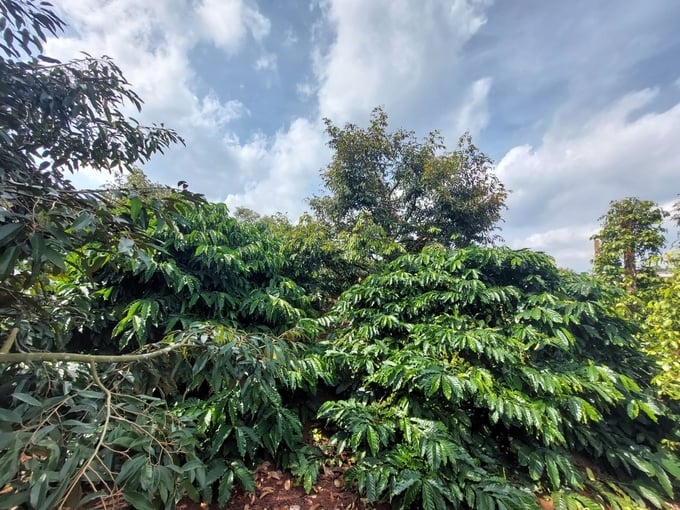
The Central Highlands is increasingly expanding the landscape coffee area. Photo: Mai Phuong.
How do you evaluate the European Commission's request asking Vietnam not to expand coffee on forest land?
I think this is a general and inevitable trend for agricultural production worldwide, not just for Vietnam. We also know that forests play a huge role in sustainable development and are an indispensable component in the landscape agro-ecosystem, an ecological phenotype that is considered sustainable and can adapt well to the current progress of climate change.
Currently, the Government is also having many programs to restore forest areas in Vietnam, especially in key areas such as the Central Highlands. We also have international commitments to reduce emissions, so it is vital that we do not expand agricultural areas in general and coffee in particular on forest land.
With such a request from the European Commission, how should we grow coffee sustainably and develop in a chain to improve the industry’s value, sir?
The coffee area of Vietnam in general and the Central Highlands in particular has exceeded the planning orientation of the Ministry of Agriculture and Rural Development, so we recommend not developing more newly planted coffee areas. Most of our current forest areas are actually located in locations with natural conditions that are not too suitable for coffee development.
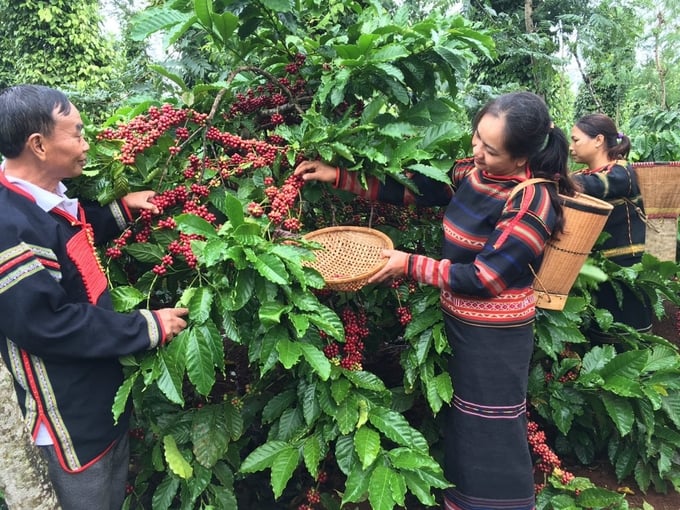
The quality of coffee is increasingly improved by harvesting 100% ripe fruit in the material selection stage. Photo: Mai Phuong.
We should have long-term orientations and measures. Accordingly, we must well manage the existing forest land, prevent and strictly handle the encroachment of forest land for agricultural production in general and coffee in particular.
For the coffee areas that have been established on the forest area in recent years, we need to have appropriate technical measures to promote forest regeneration and intercrop native large trees for complete forest restoration. As for the existing coffee areas, not only do we need to stop increasing the planting area, we also have to focus on green, sustainable, low-emissions methods, organize the production of high-quality coffee, develop processing and deep processing, building brands to effectively enhance the added value of products.
Can you please tell us how are the current models of sustainable coffee development in the direction of green, reducing greenhouse gas emissions in the Central Highlands?
There are many programs of the State and foreign organizations in the Central Highlands to help coffee producers establish sustainable development models in the green, low-emissions direction. Some mentionable examples include the landscape coffee development programs currently being implemented in a number of districts in Dak Lak and Lam Dong.
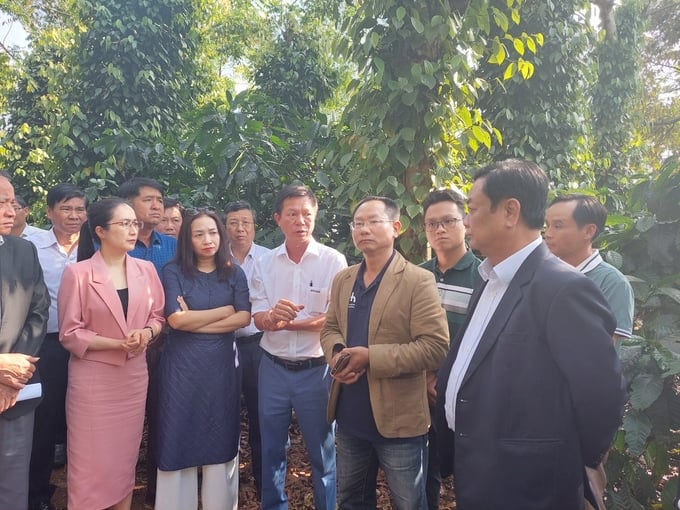
Minister of Agriculture and Rural Development Le Minh Hoan visits a landscape coffee model in Krong Nang district, Dak Lak province. Photo: Mai Phuong.
These are very basic models which base on the use of principles of agroforestry and circular agriculture. The models are well-received by many parties such as local authorities, development assistance organizations, buyers at home and abroad. We also have many models on a smaller scale that are also being supported to develop in the direction of regenerative agriculture, that is, intercropping coffee with fruit trees and native forestry trees.
What are the difficulties in implementing sustainable coffee models in the Central Highlands, sir?
Changing people's awareness in implementing sustainable coffee models is the most difficult, I believe. In the current production practice, people mainly prioritize the economic and short-term aspects over the environmental or social aspects. They mainly participate in setting up models according to programs and projects in which there is partial economic support.
Long-term maintenance of such models is a difficult issue and depends a lot on the value link chains and markets. The problem is that the organization of large-scale production still lacks the locomotives to be able to deploy all solutions in a synchronous and long-term manner in accordance with the criteria of sustainable development.
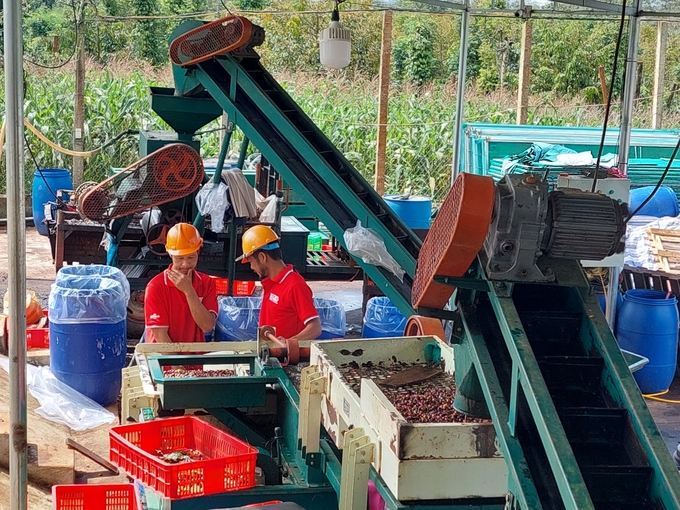
Wet processing to improve the quality of coffee beans. Photo: Mai Phuong.
So, what do you think is the solution for us to replicate sustainable coffee models in the Central Highlands?
In my opinion, to be able to replicate sustainable and high-value coffee models, we need to develop and expand production links, promote the expansion of consumer markets, boost the consumption of sustainable coffee products commensurate to their value. This means that not only can farmers sell certified coffee products, but they can also sell all other products in the model such as fruit, timber or carbon credits.
Appropriate agricultural extension programs are required to demonstrate the effectiveness of the models, especially to change people's perception of sustainable production efficiency in the long term.
Above all, there is a need for the active participation of all stakeholders and a long-term commitment to the sustainable coffee production value chain, with the foundation being policies and regulations in a regional economic development master plan, in which the government plays the leading and connecting role, enterprises play the leading role in associating with cooperatives and cooperative linkages.
Thank you, sir!
Translated by Samuel Pham

(VAN) Cold-barn systems efficiently manage environmental and temperature conditions, which aids in the prevention of respiratory diseases in pigs and protects them from the vectors that transmit African swine fevers.
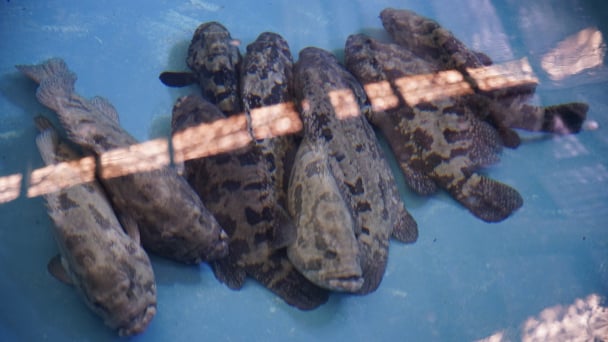
(VAN) To tackle challenges, the project 'Addressing key technical bottlenecks in the grouper supply chain in Vietnam' has been underway since 2024.

(VAN) The project 'Disease-Resilient and Sustainable Cassava Production Systems in the Mekong Region', funded by the Australian Center for International Agricultural Research (ACIAR), is being implemented from 2024 to 2028.

(VAN) Data from 10,000 farming households will help professionalize production organization and support the implementation of the One Million Hectares Program for High-Quality, Low-Emission Rice Cultivation.

(VAN) FAO Director-General QU Dongyu marks International Day of Plant Health at NENA conference.

(VAN) Deputy Minister of Agriculture and Environment Hoang Trung affirmed that floriculture and ornamental plants are a growing industry that receives significant global attention.

(VAN) The three staple crops dominating modern diets – corn, rice and wheat – are familiar to Americans. However, fourth place is held by a dark horse: cassava.